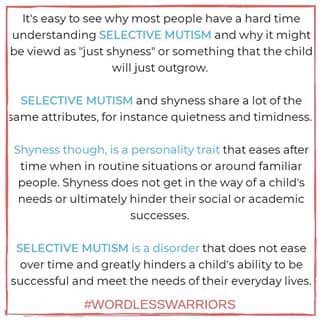
Shyness and selective mutism may seem similar, but they are two very different things. Selective mutism is an anxiety disorder, and shyness is a personality trait/emotion.

“Extreme shyness and selective mutism can be thought of as being on a continuum with selective mutism being a more severe condition. Shy children are generally able to respond when they are asked questions, even though it may be quietly and with very few words. Children with selective mutism have specific situations or people (particularly at school) where they are not able to respond verbally at all.” – Selective Mutism Clinic Article
“Shyness is an emotion that affects how a person feels and behaves around others. Shyness can mean feeling uncomfortable, self conscious, nervous, bashful, timid, or insecure. People who feel shy sometimes notice physical sensations like blushing or feeling speechless, shaky, or breathless.” – Kids Health Article
“Shy kids may not volunteer to read aloud to the class, but when they need to do things, they can. The main difference is that shy children function, whereas children with selective mutism cannot.” – Cleveland Clinic Article
It is normal for many people to feel shy, especially in new and unfamiliar situations. Shyness usually goes away when you have become more comfortable in a new place. Shyness is something most people will be able to grow out of. Selective mutism is not something that you just grow out of.
I’m not saying that people with selective mutism can’t be shy. Every individual is different so some might struggle with shyness too. It is really important though to understand that shyness and selective mutism are not the same thing. Many go undiagnosed or misdiagnosed for years because others think that they are just shy.

Selective mutism is so much more than just being shy.
